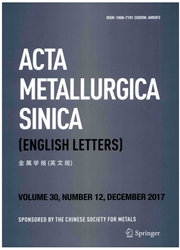

 中文摘要:
中文摘要:
在这研究, nanostructured Fe 粉末被综合与附加绝缘的障碍分泌物血浆(DBDP ) 跟随 10 小时高精力的球 milling。milled 粉末的吝啬的尺寸是有 16.2 nm 的一种平均谷物尺寸的约 100 nm。内在的谷物精炼机制上的 DBDP 的影响被扫描电子在球 milling 期间调查显微镜学(SEM ) ,传播电子显微镜学(TEM ) , X 光检查衍射(XRD ) 和赌注方法。我们的结果证明 Fe 粒子在 DBDP 的行动下面在早 milling 阶段期间显示了非凡的粘性,并且塑料变丑在这个阶段期间由 Fe 粒子经历了,这是比在正常 milling 的那件礼品更严重的。球形的 Fe 粒子的高集中,在直径的约 50100 nm,经由 TEM 被记录。我们建议这些球形的粒子在球 milling 期间由于 DBDP 电子轰炸经由高温度崩溃被产生。我们的结果建议显著地经由 DBDP 的重迭在 milling 期间精制金属性的粉末可能是可能的。
 英文摘要:
英文摘要:
In this study, nanostructured Fe powders were synthesized following 10 hours of high-energy ball milling with a superimposed dielectric barrier discharge plasma (DBDP). The mean size of the milled powder was approximately 100 nm with an average grain size of 16.2 nm. The influence of DBDP on the underlying grain refinement mechanisms during ball milling was investigated by scanning electron microscopy (SEM), transmission electron microscopy (TEM), X-ray diffraction (XRD) and BET methods. Our results show that the Fe particles displayed an extraordinary plasticity during the early milling stages under the action of DBDP, and that the plastic deformation experienced by the Fe particles during this stage was more severe than that present in normal milling. A high concentration of spherical Fe particles, approximately 50-100 nm in diameter, was documented via TEM. We propose that these spherical particles were generated via high temperature disintegration as a result of DBDP electron bombardment during ball milling. Our results suggest that it may be possible to significantly refine metallic powders during milling via the superimposition of DBDP.
 同期刊论文项目
同期刊论文项目
 同项目期刊论文
同项目期刊论文
 An uniform DBD plasma excited by bipolar nanosecond pulse using wire-cylinder electrode configuratio
An uniform DBD plasma excited by bipolar nanosecond pulse using wire-cylinder electrode configuratio Atmospheric air homogenous DBD plasma excited by bipolar nanosecond pulse used for improving the hyd
Atmospheric air homogenous DBD plasma excited by bipolar nanosecond pulse used for improving the hyd Atmospheric air diffuse array-needles dielectric barrier discharge excited by positive, negative, an
Atmospheric air diffuse array-needles dielectric barrier discharge excited by positive, negative, an Optical Diagnosis of Large Area Homogenous Dielectric Barrier Discharge in Nitrogen at Atmospheric P
Optical Diagnosis of Large Area Homogenous Dielectric Barrier Discharge in Nitrogen at Atmospheric P The effect of dielectric thickness on diffuse nanosecond dielectric barrier discharges using a needl
The effect of dielectric thickness on diffuse nanosecond dielectric barrier discharges using a needl A large-area diffuse air discharge plasma excited by nanosecond pulse under a double hexagon needle-
A large-area diffuse air discharge plasma excited by nanosecond pulse under a double hexagon needle- Electrical and optical characteristics of diffuse nanosecond pulsed discharge plasma using a needle-
Electrical and optical characteristics of diffuse nanosecond pulsed discharge plasma using a needle- Optical study of a diffuse bipolar nanosecond pulsed dielectric barrier discharge with different die
Optical study of a diffuse bipolar nanosecond pulsed dielectric barrier discharge with different die Rotational, Vibrational, and Excitation Temperatures in Bipolar Nanosecond-Pulsed Diffuse Dielectric
Rotational, Vibrational, and Excitation Temperatures in Bipolar Nanosecond-Pulsed Diffuse Dielectric Effect of dielectric material on bipolar nanosecond pulse diffuse dielectric barrier discharge in ai
Effect of dielectric material on bipolar nanosecond pulse diffuse dielectric barrier discharge in ai Multiple current peaks in room-temperature atmospheric pressure homogenous dielectric barrier discha
Multiple current peaks in room-temperature atmospheric pressure homogenous dielectric barrier discha The Brush-Shape Device Used to Generate Atmospheric and Homogeneous Plasmas for Biomedical Applicati
The Brush-Shape Device Used to Generate Atmospheric and Homogeneous Plasmas for Biomedical Applicati An atmospheric air gas-liquid diffuse discharge excited by bipolar nanosecond pulse in quartz contai
An atmospheric air gas-liquid diffuse discharge excited by bipolar nanosecond pulse in quartz contai 期刊信息
期刊信息
